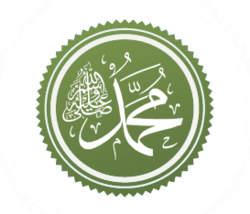Muhammad's views on Christians
| Part of a series on |
| Muhammad |
|---|
|
Views |
|
Perspectives |
|
Related |
|
Muhammad's views on Christians were demonstrated through his interactions with them. He interacted with Christians while in Mecca, and sent a force to fight the Byzantines at the Battle of Mu'tah.
Islamic Prophets |
|---|
 |
|
Listed by Islamic name and Biblical name. The six marked with a * are considered major prophets.
|
|
|
Before the First Revelations
At the age of nine, or according to some sources twelve, Muhammad went to Syria with his uncle Abu Talib and had interactions with Christians. One important contact was with the Nestorian monk Bahira in Bosra, modern Syria who foretold to the adolescent Muhammad his future prophetic career.[1] This narrative is found in multiple accounts of Sira literature.
Another narrative found in the Sira of Ibn Sa'd shows that while Muhammad was working for Khadija, she had him go on a journey to Syria along with a man named Maysarah. Once they reached Bostra in the south of Syria, Muhammad was reported to have taken shelter underneath a tree. A monk named Nestor approached Maysarah asking him who was the man underneath the tree. Explaining to the monk whom he was, Nestor quickly responded, "None other than a Prophet is sitting beneath that tree."
Waraqah ibn Nawfal was a Nestorian monk, first cousin to Muhammad's wife Khadija, and Mecca's priest or preacher according to some sources. He was the first man to tell Muhammad that he was a prophet based on the first revelation he received in the cave of Hira.
Meccan period
Waraqah is said to have believed in Muhammad as a true prophet, but remained a Christian.
After the early Sahaba ("Companions") faced intense persecution from the Meccan elites, Muhammad sent 90 of his followers to Abyssinia. There the Muslims were received by the Christian king Aṣḥama ibn Abjar. Ashama was known to have been one of Muhammad's close companions.
There are a few revelations of the Qur'an revealed in the Meccan period which seem to promote tolerance of Christians as People of the Book.
According to the tradition preserved at Sinai, Muhammed both knew and visited the monastery and the Sinai fathers. The Koran makes mention of the Sinai holy sites. In the second year of the Hegira, corresponding to AD 626, a delegation from Sinai requested a letter of protection from Mohammed. This was granted, and authorized by him when he placed his hand upon the document. In AD 1517, Sultan Selim I confirmed the monastery’s prerogatives, but took the original letter of protection for safekeeping to the royal treasury in Constantinople. At the same time, he gave the monastery certified copies of this document, each depicting the hand print of Mohammed in token of his having touched the original.[2]
Byzantines
According to traditional Islamic sources, in 628 Muhammad sent a letter to Heraclius inviting him to Islam. The Byzantine emperor received it while on a pilgrimage in Jerusalem and called upon a person who belonged to Muhammad's tribe Quraysh. According to Sunni tradition, Abu Sufyan ibn Harb came forward and a discussion between them took place.[3] At the end of the discussion the emperor said,
If what you say should be true, he will very soon occupy the earth under my feet, and if I knew that I would reach him definitely, I would go immediately to meet Him; and were I with him, then I would certainly wash his feet.[4]
In 629 according to tradition, Muhammad sent a force of 3,000 men to fight 100,000 Byzantines near Al Karak. The Battle of Mu'tah ended when both sides retreated.
Narrated 'Aisha and 'Abdullah bin 'Abbas: When the last moment of the life of Allah's Apostle came he started putting his 'Khamisa' on his face and when he felt hot and short of breath he took it off his face and said, "May Allah curse the Jews and Christians for they built the places of worship at the graves of their Prophets." The Prophet was warning (Muslims) of what those had done.
It has been narrated by 'Umar b. al-Khattib that he heard the Messenger of Allah say: I will expel the Jews and Christians from the Arabian Peninsula and will not leave any but Muslim.
Narrated AbuHurayrah: The Prophet said: There is no prophet between me and him, that is, Jesus. He will descent (to the earth). When you see him, recognise him: a man of medium height, reddish fair, wearing two light yellow garments, looking as if drops were falling down from his head though it will not be wet. He will fight the people for the cause of Islam. He will break the cross, kill swine, and abolish jizyah. Allah will perish all religions except Islam. He will destroy the Antichrist and will live on the earth for forty years and then he will die. The Muslims will pray over him.
The Christians of Najran Interaction with Muhammad during the Medina Period
The city of ancient-Najran, which is called Ukhdud today, is located just outside present-day Najran approximately 1200 miles south of Medina. Ancient-Najran was a Christian city located at the intersection of two main caravan routes. The city was also in a particular geographical place which allowed it to boom with agriculture and industry making it an ideal center of trade. One can infer that this played a significant role in Muhammad’s interest in the city. Due to this interest, the Christian identity became vulnerable to Islam first in the Meccan period with the increase of the Qu’ran availability throughout the Arabian Peninsula. However, it was not until the Medina Period that the first interactions between the Christians of Najran and Muhammad took place.[5]
It was during Muhammad’s time in Medina that he began inviting different groups to Islam. He sent two envoys specifically to Najran; one of them being the Islamic leader Khalid ibn al-Walid who would protect the people’s ability to practice Christianity under Islamic government.[6]
So in response, Najran sent a delegation of Christian scholars with the interest of investigating the Prophet’s revelations. Their group was met with hospitability and security from the Prophet. The delegation and Muhammad met for two or three days, according to some sources, debating peacefully about their religions. The debates ended in an understanding that each religion would leave the other alone.[7]
Here is the link to the Covenant between Muhammad and the Najrans: [8](located under the heading Covenant with the Christians of Najran).
And here are the terms in which the covenant was to be kept: In the name of God, the Merciful, the Beneficent. This is what Muhammad, the Prophet and God’s Messenger, has written down for the people of Najran when he has the authority over all their fruits, gold, silver, crops and slaves. He has benevolently left them all that in return for 2,000 hullas every year, 1,000 to be given in the month of Rajab and 1,000 in the month of Safar. Each hulla is equal to one ounce [a measure equal to 4 dirhams]. The Najran are also required to provide accommodation and expenses for my messengers, for up to 20 days. None of my messengers shall be kept in Najran more than one month. They are also required to give, as a loan, 30 shields, 30 horses and 30 camels, in case of any disorder and treachery in Yemen. If anything is lost of the shields, horses or camels they loan to my messenger, it will remain owing by my messenger until it is given back. Najran has the protection of God and the pledges of Muhammad, the Prophet, to protect their lives, faith, land, property, those who are absent and those who are present, and their clan and allies. They need not change anything of their past customs. No right of theirs or their religion shall be altered. No bishop, monk or church guard shall be removed from his position. Whatever they have is theirs, no matter how big or small. They are not held in suspicion and they shall suffer no vengeance killing. They are not required to be mobilized and no army shall trespass on their land. If any of them requests that any right of his should be given to him, justice shall be administered among them. He who takes usury on past loans is not under my protection. No person in Najran is answerable for an injustice committed by another.[9]
This covenant remained intact after the death of Muhammad until the second caliph, Umar, expelled the Christians of Najran due to violations of the peace. He sent them to Iraq where there were to be taken as refugees and provided settlement.[10]
See also
Notes
- ↑ Haykal, The Life of Muhammad, American Trust Publications, p.54
- ↑ http://www.sinaimonastery.com/en/index.php?lid=68#
- ↑ Siddiqui (2007)
- ↑ Sahih al-Bukhari, 4:52:191
- ↑ Shahid, Irfan. "Nadjran". Encyclopedia of Islam, Second Edition. Brill Online, 2013. Retrieved 3 November 2013.
- ↑ Tobi, Joseph (1999). The Jews of Yemen: Studies in Their History and Culture. Leiden, Netherlands: Koninklijke Brill NV. p. 20.
- ↑ Acar, Ismail. "Interactions between Prophet Muhammad and Christians". The Fountain on Life, Knowledge, and Belief. Retrieved 3 November 2013.
- ↑ Muhammad. "The Covenant of the Prophet Muhammad with the Christians of Najran.". The Covenant of the Prophet Muhammad with the Christians of the World. Retrieved 3 November 2013.
- ↑ Salahi, Adil. "Prophet Muhammad Meets Najran Christians.". OnIslam. Retrieved 3 November 2013.
- ↑ Abd al-Muhsin Madʼaj M Madʼaj. (1988). The Yemen in Early Islam (9-233/630-847): A Political History. London: Ithaca Press. p. 112.
References
- Al-Jibouri, Yasin T. Khadija Daughter of Khuwaylid, (accessed January 8, 2007)
- Siddiqui, Muzammil. Prophet Muhammad as a Political Leader (accessed January 8, 2007)
